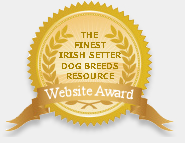Judging Irish Setters in Australia
.
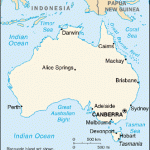
Judging in Australia
In Australia ANKC requires all persons judging, including those officiating from overseas countries, to adhere the Irish Setter Breed Standard – Kennel Club, 1994.
(However as of 1 January 2009 there is an additional paragraph added to all breed standards in UK (added below).)
Important Notice from Irish Setter Association, England:
As many members will be aware from reading the canine press, the Kennel Club has very recently undertaken a major review of all breed standards as part of their response to the call to ensure the future good health of pedigree dogs.
As a results, with effect from 1st January 2009 all breed standards will include a new introductory paragraph shown below:
The Kennel Club review has not led to any recommendations to amend the main body of the existing Irish Setter breed standard.
We have reproduced this additonal information for Members information and future reference.
A Breed Standard is the guideline which describes the ideal characteristics, temperament and appearance of a breed and ensures that the breed is fit for function. Absolute soundness is essential. Breeders and judges should at all times be careful to avoid obvious conditions or exaggerations which would be detrimental in any way to the health, welfare or soundness of this breed. From time to time certain conditions or exaggerations may be considered to have the potential to affect dogs in some breeds adversely, and judges and breeders are required to refer to the Kennel Club website for details of any such current issues. If a feature or quality is desirable it should only be present in the right measure.
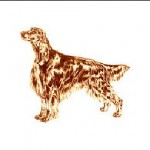


ANKC Irish Setter Breed Standard
General Appearance: Must be racy, balanced and full of quality. In conformation, proportionate.
Characteristics: Most handsome and refined in looks, tremendously active with untiring readiness to range and hunt under any conditions.
Temperament: Demonstrably affectionate.
Head And Skull: Head long and lean, not narrow or snipy, not coarse at the ears. Skull oval (from ear to ear) having plenty of brain room and well-defined occipital protuberance. From occiput to stop and from stop to tip of nose to be parallel and of equal length, brows raised showing stop. Muzzle moderately deep, fairly square at end. Jaws of nearly equal length, flews not pendulous, nostrils wide. Colour of nose dark mahogany, dark walnut or black.
Eyes: Dark hazel to dark brown, not too large, preferably like an unshelled almond in shape, set level (not obliquely), under brows showing kind, intelligent expression.
Ears: Of moderate size, fine in texture, set on low, well back and hanging in a neat fold close to head.
Mouth: Jaws strong with a perfect, regular and complete scissor bite, i.e. Upper teeth closely overlapping the lower teeth and set square to the jaws.
Neck: Moderately long, very muscular but not too thick, slightly arched and free from all tendency to throatiness, setting cleanly without a break of topline into shoulders.
Forequarters: Shoulders fine at points, deep and sloping well back. Forelegs straight and sinewy having plenty of bone, with elbows free, well let down and not inclined either in nor out.
Body: Chest as deep as possible, rather narrow in front. Ribs well sprung leaving plenty of lung room and carried well back to muscular loin, slightly arched. Firm straight topline gently sloping downwards from withers.
Hindquarters: Wide and powerful. Hindlegs from hip to hock long and muscular, from hock to heel short and strong. Stifle and hock joints well bent and not inclined either in nor out.
Feet: Small, very firm; toes strong, close together and arched.
Tail: Of moderate length proportionate to size of body, set on just below the level of the back, strong at root tapering to a fine point and carried as nearly as possible on a level with or below the back.
Gait/Movement: Free flowing, driving movement with true action when viewed from front or rear, and in profile, showing perfect co-ordination.
Coat: On head, front of legs and tips of ears, short and fine, on all other parts of body and legs of moderate length, flat and as free as possible from curl or wave. Feathers on upper portion of ears long and silky; on back of fore and hindlegs long and fine. Fair amount of hair on belly, forming a nice fringe which may extend on chest and throat. Feet well feathered between toes. Tail to have fringe of moderately long hair decreasing in length as it approaches point. All feathering to be as straight and flat as possible.
Colour: Rich chestnut with no trace of black. White on chest, throat, chin or toes, or small star on forehead or narrow streak or blaze on nose or face not to disqualify.
Sizes: Not Specified.
Faults: Any departure from the foregoing points should be considered a fault and the seriousness with which the fault should be regarded should be in exact proportion to its degree and its effect upon the health and welfare of the dog.
Notes: Male animals should have two apparently normal testicles fully descended into the scrotum.
.
Definition of Champion/Grand Champions/Supreme Grand Champions
A dog needs to accumulate a total of:-
- 100 points to become a Champion and
- 1,000 points to become a Grand Champion*
Points are awarded at the judges discretion to be best of each sex of each breed (over six months of age) at a championship show, there are also additional points allocated to the Best of Breed winner.
Challenge points are calculated as follows, five (5) points plus one (1) point for each dog in competition (over six months of age). The maximum points available to any exhibit at any one show is twenty-five (25) points.
Champions are made up from the classes (although puppies must win a challenge after the age of 12 mths) and can continue to compete with the class dogs. To be awarded championship titles the winning animal may have to compete against previously titled dogs.
* As from 1 January 2010 the qualifications required to attain the Grand Champion Title will be:
- 1,000 points including
- 1 All Breeds Best in Show; or
- 4 Best in Group; or
- 4 Certificates of 25 points (these could be Group, BOB or Challenge)
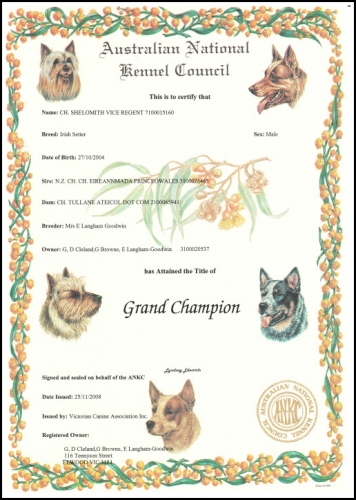

SUPREME CHAMPION
ANKC REGULATION
7.10 Supreme Champion (10/11)
a) Using the points system as approved by the ANKC Ltd at the time, an animal will be required to attain the following qualifications to be eligible to the title of Supreme Champion.
1,000 points, including 3 All Breeds Best in Shows; or 10 Best in Group/Specialty Best in Show.
Either 3 different Best in Show Judges or 10 different Best in Group/Specialty judges must be submitted, there can be no repeated judges.
b) The implementation date for the awarding of the title of Supreme Champion be 1 July 2012.
c) A Supreme Championship will not be awarded to animals retrospectively, but an animal will be eligible to be awarded the title of Supreme Champion, if they gain some points towards the title of Supreme Champion (1000 points) after the
implementation date of the 1 July 2012.
.
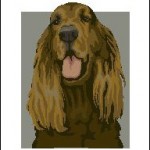
Irish Setter Club of Victoria – Dog & Bitch of the Year
This competition is held by the ISCV for its members (over a year) by selecting premier shows each month as points score shows. Generally, the Committee of the Club chooses shows which are judged by breed specialists (if possible) or gundog/sporting dog judges.
Although the process for selection has changed from year to year, the format for 2009 was: one show each month, plus the Irish Setter Club of Victoria’s Championship Show. The shows chosen also include Melbourne Royal Show & Victorian Gundog Club Championship Show – the next largest breed entry to the specialty.
Points were scored by winning either dog challenge or bitch challenge (3 points). There is a point awarded for reserve challenge as well (not just to be utilised in the case of a count back situation)
.
Past Winners of Irish Setter Club of Victoria’s Dog/Bitch of the Year Competition
2008-09
Gr Ch Shelomith Vice Regent (Cleland/Browne/Langham-Goodwin OAM)
Gr Ch Pendoric Fire Anythyme (Hearn)
2007-08
Ch Brodruggan Temptation (Stewart)
Ch Rhiannon Resplendence (Scott)
2006-07
Gr Ch Shelomith Vice Regent (Cleland/Browne/Langham-Goodwin OAM)
Ch Rhiannon Resplendence (Scott)
2005-06
Gr Ch Shelomith Vice Regent (Cleland/Browne/Langham-Goodwin OAM)
Ch Eirean Secret Affair (AI) (Anderson)
2004-05
abandoned
2003-04
to be confirmed
2002-03
to be confirmed
? Gr Ch Gwyndara Total Eclipse (Jones)
? Gr Ch Quailmoor Capucci (Malloy)
2001-02
Gr Ch Gwyndara Total Eclipse (Jones)
Gr Ch Quailmoor Capucci (Malloy)
2000-01
Gr Ch Gwyndara Total Eclipse (Jones)
Gr Ch Quailmoor Capucci (Malloy)
1999-00
Gr Ch Eireannmada At Harvard (Cleland/Browne)
Gr Ch Quailmoor Capucci (Malloy)
1998-99
Gr Ch Eireannmada At Harvard (Cleland/Browne)
Gr Ch Quailmoor Capucci (Malloy)
1997-98
Gr Ch Eireannmada At Harvard (Cleland/Browne)
Gr Ch Pendoric Fire N Ice (AI) (Hearn)
1996-97
Ch Pendoric Pandemonium (AI) (Hearn)
Gr Ch Pendoric Fire N Ice (AI) (Hearn)
.
.
DogzOnline* Point Score Competition
Unlike the American ratings system which is based on all dogs’ wins at all shows, this points score competition is an online ratings system (for all breeds) offered to dogs who register to take part.
The pointscore is split into four individual competitions (State & National):
o Show Dog of the Year
o Breed Competition
o Rising Star of the Year
o Breeder of the Year
It is a relatively new competition and is held in Australia between 1st January and 31st December.
* For more detailed description of this competition, please go to LINKS page and see DogzOnline
.
.
.
.
.
.
.
.
.
.
An Extension to the Irish Setter Breed Standard?
The Irish Setter Breed Standard is a subject which has generated much interest and discussion amongst breeders, judges and exhibitors over the years here in Australia. Since ANKC offers the opportunity for submissions by breed clubs to elaborate on details of the existing breed standard various meetings have been held where productive ideas and views have been exchanged.
Notes from a meeting of interested members of the Irish Setter Club of Victoria in 2000 display how interpreting the Standard may be improved.
Since many years have passed without submitting to the ANKC for consideration, the Irish Setter Club of Victoria has recently called members to contribute once again to the process of developing and extension to the Breed Standard.
Below are the notes I have on file from the meeting and feel positive discussion between all members about various details would benefit a clearer image of the Irish Setter Standard.
GENERAL APPEARANCE
. racy
. refined, streamlined and elegant in appearance
. active, aristocratic, substantial yet elegant in appearance
. athletic, long on leg ‘steel and whalebone rather than strength and muscle’
(The Native Dogs of Ireland)
. racy, balanced and full of quality, therefore the conformation of the Irish Setter must be in harmony, without exaggeration to any part of the body
. a fit, balanced and sporting dog with every part of the body flowing smoothly into the next without any ugly breaks, lumps and bumps (Eve Gardner)
. must give the impression of a racy, elegant throughbred
. full of quality – superior excellence or finesse
. tallest in station of all the setters
CHARACTERISTICS
. aristocratic, keen and intelligent
. rollicking
. demonstrative and affectionate
. high head carriage adds to commanding presence
TEMPERAMENT
. should give the impression of friendliness and intelligence
. never cringing, never wild or vicious, never wary or aloof
. outgoing personality should be evident
. a rollicking personality
. shyness, hostility or timidity are foreign to the breed
. outgoing, stable – is the essence (US)
HEAD & SKULL
. Description from Peter Frost’s breed lecture notes
. long & lean, not narrow or snipey, without courseness
. skull oval when viewed from above or front
. length at least double the width between the ears
. beauty of head is emphasised by delicate chiselling around and below eyes and along cheeks
. raised brows showing stop
. viewed from the side, planes are parallel
. occiput well defined
. muzzle not as deep as that of the English or Gordon
. Underline of jaw almost parallel with top line of muzzle
NOSE
. large, dark, well developed wide nostrils are essential
EYES
. dark hazel to dark brown
. too light and eye is foreign to breed expression
. somewhat almond shaped
. set level, not obliquely
EXPRESSION
. wistful, soft yet alert. Can change from soft, kind, to bright & mischievious all in the twinkle of an eye. Without this ability, something of the true irish setter character is lost.
. not prominent or loose
EARS
. set well back – low, not above the level of the eye
. leather fine in texture
.hanging in a neat fold close to the head
.moderate size, nearly long enough to reach the nose
MOUTH
. jaws strong, scissor bite
FOREQUARTERS
. refinement at point of shoulder (junction of the scapula and humerus bones) and at the withers
. the forearm is muscular and slightly longer than the upper arm
. shoulder blades long, wide, sloping well back fairly close together at withers. Upper arm and shoulder blades are approx the same length and are joined at sufficient angle to bring the elbows rearward along the brisket in line with the top of the withers
. the elbows moving freely, inclined neither in nor out
. forelegs are strong, straight and sinewy
. viewed from the front, the elbows and legs are perpendicular
. from the side, the legs are well boned with nearly straight pasterns
. it is important pasterns (region between wrist and front foot) and feet continue this same straight line
. strong, nearly straight pasterns
. feet rather small, very firm, toes arched and close
BODY
. not a square dog. The general accepted balance is height/length ratio of 9:10 (point of shoulder to rear buttock)
. a sufficiently long dog is also more’ ‘scopy’ – an irish setter with a very short back not only looks wrong but lacks elegance. Crabbing will result as the dog has to move sideways to prevent the back feet from touching the front
. body sufficiently long enough to enable a long & free ground covering stride
. chest as deep as possible, rather narrow in front but not so wide or round as to interfere with the action of forelegs
. viewed from front, the Irish is the narrowest of the setters
. ribbing
TOPLINE
. the gently sloping topline distinguishes the irish setter from other setter varieties. Free standing or in motion the topline of the dog should be firm and flow gently from the withers without a break nor with a sharp drop at the croup
HINDQUARTERS
. angulation of the forequarters and hindquarters should be balanced. This is essential for efficient movement (illustration to be added)
. stifle and hock joints well bent and like the elbows, inclined neither in nor out
FEET
. well cushioned pads
TAIL
. as a natural extension of the topline
. apart from being one of the beautiful parts of the irish’s furnishings is next to the eyes, the most expressive part of the irish setter’s make up. It communicates how the dog feels about things. It is also an important communicator of information to the hunter.
. if the tail is set on correctly and allied with a moderately sloping croup (the portion of the topline extending from the hip bones to the set on of the tail) it will be carried in the desirable manner
GAIT/MOVEMENT
. crossing and weaving undesirable
. on the move, the correctly constructed remains balanced at all times, keeping the firm gently sloping topline
. US standard description
COAT
. the irish setter’s coat in its glorious colour is the crowning glory of the breed. The frequency with which white markings appear are a reminder of the origins of the breed.
